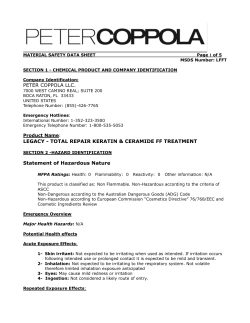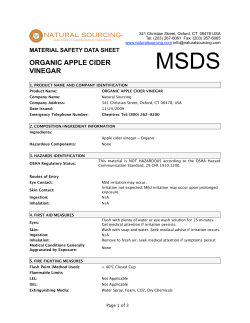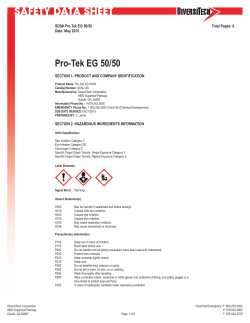
ALLOYSolv (Part A) MSDS
ALLOYSolv DATE OF ISSUE: June 2012 PAGE 1 OF 5 MATERIAL SAFETY DATA SHEET Hazardous According to the Criteria of NOHSC Section I - IDENTIFICATION OF THE MATERIAL AND SUPPLIER Product Name: Other Name: Manufacturer’s Product Code: Recommended Use: ALLOYSOLV None KT-CC-ALS SOLVENT COMPONENT OF ALLOY SYSTEM Supplier Name: Supplier Address: KLEENTEK ADVANCED CLEANING TECHNOLOGIES 10/100 SUGAR ROAD MAROOCHYDORE, QLD, 4558 07 5443 6020 07 5443 6021 07 5443 6020 www.kleentek.net.au Telephone No.: Fax No.: Emergency No.: Website: Section 2 - HAZARDS IDENTIFICATION Hazard Designation: Hazardous According to the Criteria of NOHSC Hazard Category: Harmful Risk phrases: R20/22 – Harmful by inhalation and if swallowed Safety phrases: S2: Keep out of reach of children. S26: Inn case of eye contact, rinse immediately with plenty of water and contact a doctor or Poisons Information Centre. In-Use Hazards: An in-use solution of less than 25% is not classified as hazardous according to the criteria of NOHSC Australia Section 3 - COMPOSITION/INFORMATION ON INGREDIENTS INGREDIENT BENZYL ALCOHOL SURFACTANTS CAS NUMBER 100-51-6 PROPORTION (W/W) Greater than 60% 1 to 10% Section 4 - FIRST AID MEASURES IF POISONING OCCURS, IMMEDIATELY CONTACT A DOCTOR OR POISONS INFORMATION CENTRE (TELEPHONE AUS: 13 11 26, NZ: 03 474 7000), AND FOLLOW THE ADVICE GIVEN. SHOW THIS MATERIAL SAFETY DATA SHEET TO A DOCTOR. ALLOYSolv DATE OF ISSUE: June 2012 PAGE 2 OF 5 Inhalation: Open all doors, windows and/or vents. Move victim to fresh air. Apply resuscitation if victim is not breathing – If trained personnel available administer oxygen if breathing is difficult. Skin Contact: If material is splashed onto the skin, remove any contaminated clothing and wash skin thoroughly with water and soap if available. If irritation persists transport to hospital or doctor. Eye contact: If material is splashed into eyes, immediately, flush with plenty of water for 15 minutes, ensuring eye lids are held open. If irritation persists transport to hospital or doctor. Ingestion: If swallowed, DO NOT induce vomiting, unless instructed to do so by trained health professional. Transport to hospital or doctor. First Aid Facilities: Eye wash fountain, safety shower and normal wash room facilities. Symptoms: Not available Medical attention: Treat symptomatically Section 5 - FIRE FIGHTING MEASURES Fire/Explosion Hazard: If safe to do so, move undamaged containers from fire area. Hazardous Decompostion Products: May decompose on heating emitting soot, smoke and decomposition products. Fire Fighting Procedures Fire fighters to wear Self-contained breathing apparatus (SCBA) in confined spaces, in oxygen deficient atmospheres or if exposed to products of decomposition. Full protective clothing is also recommended. Extinguishing Media: Use extinguishing media suitable for surrounding fire situation. Flammability: This material is not a flammable or combustible liquid. Section 6 - ACCIDENTAL RELEASE MEASURES Ventilate area. Remove all unnecessary personnel from spill area. Wear protective equipment to prevent skin and eye contact, as outlined under personal protection in this MSDS. Contain using sand or soil - prevent run off into drains and waterways. Use absorbent (soil, sand, vermiculite or other inert material). Do not use sawdust. Collect and seal in properly labelled containers for disposal. Disposal: For disposal information contact the State Land Waste Management Authority or the Environmental Protection Agency. Section 7 - HANDLING AND STORAGE Store in a cool place and out of direct sunlight. Store away from sources of heat or ignition, strong acids, combustibles and oxidizing agents. Store in original packages as approved by manufacturer. For further information please refer to the Engineering Controls of this MSDS. Section 8 - EXPOSURE CONTROLS/PERSONAL PROTECTION ALLOYSolv DATE OF ISSUE: June 2012 PAGE 3 OF 5 Exposure Standards: No exposure standards have been assigned by [NOHSC] for this product or any of the components Engineering Controls: Maintain adequate ventilation at all times. In most circumstances natural ventilation systems are adequate unless the material is heated, reacted or otherwise changed in some type of chemical reaction, then the use of a local exhaust ventilation system is recommended. Personal Protective Equipment: GLOVES: PVC, Nitrile, Neoprene, Natural rubber or any other type of glove are recommended. EYES: Chemical goggles or faceshield to protect eyes. RESPIRATORY PROTECTION: Avoid breathing of vapour or mist. Select and use respirators in accordance with AS/NZS 1715/1716. Section 9 - PHYSICAL AND CHEMICAL PROPERTIES Appearance: Boiling Point: Vapour Pressure: Specific Gravity: Flash Point: Flammability Limits: Solubility in Water: Other Properties: Clear colourless liquid 205 deg. C (approx.) Not known 1.04 101 deg. C Not known Insoluble pH 1% 10.0 Section 10 - STABILITY AND REACTIVITY Chemical Stability: Hazardous Decomposition Products: Hazardous Polymerization: Incompatibilities: Conditions To Avoid: Stable under normal conditions of use. Emits choking and corrosive fumes when heated to decomposition. Will not occur Oxidizing agents Heat, flames, ignition sources and incompatibles. Section 11 - TOXICOLOGICAL INFORMATION No adverse health effects are expected, if the product is handled in accordance with this Material Safety Data Sheet and the product label. Symptoms and effects that may arise if the product is mishandled and overexposure occurs are: ACUTE HEALTH EFFECTS ALLOYSolv DATE OF ISSUE: June 2012 PAGE 4 OF 5 Swallowed: Harmful if swallowed. May cause irritation to mouth, throat and stomach with effects including mucous build up, irritation to the tongue and lips and pains in the stomach. Eye: May cause irritation to the eyes, with effects including: tearing, pain, stinging and blurred vision. Skin: May cause irritation to the skin, with effects including; Redness and itchiness. Inhaled: Harmful if inhaled. May cause irritation to the nose, throat and respiratory system with effects including: Dizziness, headache and possible confusion. Chronic: Prolonged or repeated exposure may lead to irreversible damage to health. Section 12 - ECOLOGICAL INFORMATION This substance may cause long term adverse effects in the aquatic environment. Section 13 - DISPOSAL CONSIDERATIONS Whatever cannot be saved for recovery or recycling should be handled as hazardous waste and sent to an approved waste facility. Processing, use or contamination of this product may change the waste management options. State and local disposal regulations may differ from federal disposal regulations. Dispose of container and unused contents in accordance with federal, state and local requirements. Section 14 - TRANSPORT INFORMATION UN Number: Proper Shipping Name: Dangerous Goods Class: Subsidiary risk: Packing Group: Hazchem Code: None allocated None Allocated None allocated None allocated None allocated None allocated Not classified as a Dangerous Good according to the UN, DOT(US), WHIMS, IACO(IATA) or IMO(IMDG). Non Dangerous Good according to the ADG Code (6th Edition) . Section 15 - REGULATORY INFORMATION Poison Schedule: Inventory Status: HSNO NZ Classification None allocated Australia (AICS) All ingredients are on the inventory. 6.1D 8.2B 6.5B 9.1D 9.2B 9.3C Solvents, Subsidiary Hazard ALLOYSolv DATE OF ISSUE: June 2012 PAGE 5 OF 5 Section 16 - OTHER INFORMATION Trademark information: Preparation information: New product MSDS, Reason for update: New, and conversion to 16 heading format. Data sources: This MSDS summarises our best knowledge of the health and safety hazard information of the product and how to safely handle and use the product in the workplace. Each user should read this MSDS and consider the information in the context of how the product will be handled and used in the workplace including in conjunction with other products. If clarification or further information is needed to ensure that an appropriate risk assessment can be made, the user should contact this company. Since methods and conditions are beyond our control Eco Precision Cleaning and its associated companies does not accept liability for any damages resulting from the use of, or reliance on, this information in inappropriate contexts. Revision Date: June 2012 Supersedes : May 2012 END OF MSDS
© Copyright 2025

















